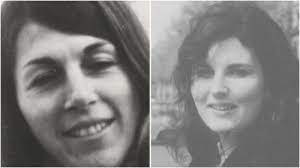Easey Street Murders: Case Of Suzanne Armstrong And Susan

The sister of one of two women killed in their inner-Melbourne home 40 years ago has made an emotional plea to the public for information, as a police offer a $1 million reward for help to solve the crime.
In January 1977, Suzanne Armstrong (28) and Susan Bartlett (27) were fatally stabbed in their home on Easey Street in Collingwood. According to police, the attacker sexually assaulted and stabbed Armstrong, and Bartlett was stabbed after coming to her friend's aid upon hearing the commotion.
Gregory, the 16-month-old son of Suzanne Armstrong, was discovered unharmed in his crib three days after the attack. He was later raised by Armstrong's sister, Gayle. According to Gayle, it was Gregory's cries that alerted the neighbors to the disturbance.
"Gregory was 18 months old when he was found in his crib after two days. It was his crying that eventually alerted the neighbor next door, leading to their discovery," said Gayle.
"I was his mum and in recent years he has found his own father and he visits them regularly and has got quite close to them, so he's going OK."
As part of their investigation, police have conducted DNA tests on multiple individuals, but the identity of the killer remains unknown. While some people have been ruled out as suspects, the investigation continues. The murder took place in the Easey Street house in 1977, where Armstrong and Bartlett lived.
Detective Inspector Michael Hughes of the Homicide Squad stated that police have approximately 130 individuals of interest in the case, many of whom were previously investigated. The ongoing investigation involves ruling out each person, starting with those who are still alive.
According to Detective Hughes, 41 of the 130 persons of interest have already passed away. Despite this, he reported that the investigation has made substantial progress with the remaining individuals on the list. The killer, now believed to be in their 60s or 70s, is unlikely to have lived a life free of crime since the murders occurred 45 years ago, stated Detective Hughes.
"I don't believe you can commit a crime with this brutality and go unnoticed by police, whether it be in Victoria or somewhere else," he said. "I think technology will catch up with him, and our persistence if he's on that list will catch up with him." 'Only the killer has something to hide.
According to police, Armstrong and Bartlett were childhood friends from Benalla and had a close-knit group of friends in Melbourne. Detective Hughes noted that Collingwood, where the murders took place, was a working-class neighborhood where residents felt secure at the time of the incident.
The Easey Street house where Suzanne Armstrong and Susan Bartlett were murdered in 1977.(Supplied: Victoria Police)
Detective Hughes described the murders as a horrific crime that shook Melbourne, which was a relaxed city at the time where it was not uncommon for people to leave their doors and windows unlocked.
Initial investigations found no signs of forced entry to their home.
Before the two women's bodies were discovered, two notes were left at the house, police said.
Inspector Hughes urged anyone who was interviewed during the time of the murders to contact Crime Stoppers. The first body was discovered pinned to the front door by neighbors who had found the woman's stray dog, while the second body was left inside the house by the boyfriend of the victim, who went to the location with his brother searching for his girlfriend.
"People have changed addresses, moved locations, we've had scant detail on some that may have just been spoken to very briefly on the night or within a couple of days," he said.
"If you're going to offer your DNA, we'll certainly do that, the only person who's got anything to hide here is the offender."
Since the passing of her sister, Gayle Armstrong stated that she has been unable to watch the news, it was, "all concerning people like me".
She became emotional when asked what it meant to her that police were still actively involved in trying to find the killer.
"[It means] everything, everything. It's something that has to be finalized and this reward should have been offered 39 years ago and it'd be solved and we wouldn't be doing all this now."
"I hear the miracles that [police] do solve [cases] and I think Suzanne will be next," she said.
Gayle Armstrong
"They will do it, they will find this person. With the DNA, even if this person is dead, you can now go to family members and find out that way if it was that person."
The Director of Public Prosecutions will also consider granting an indemnity from prosecution to anyone who can help solve the case.

 My First News Item
My First News Item My Nine News Item
My Nine News Item